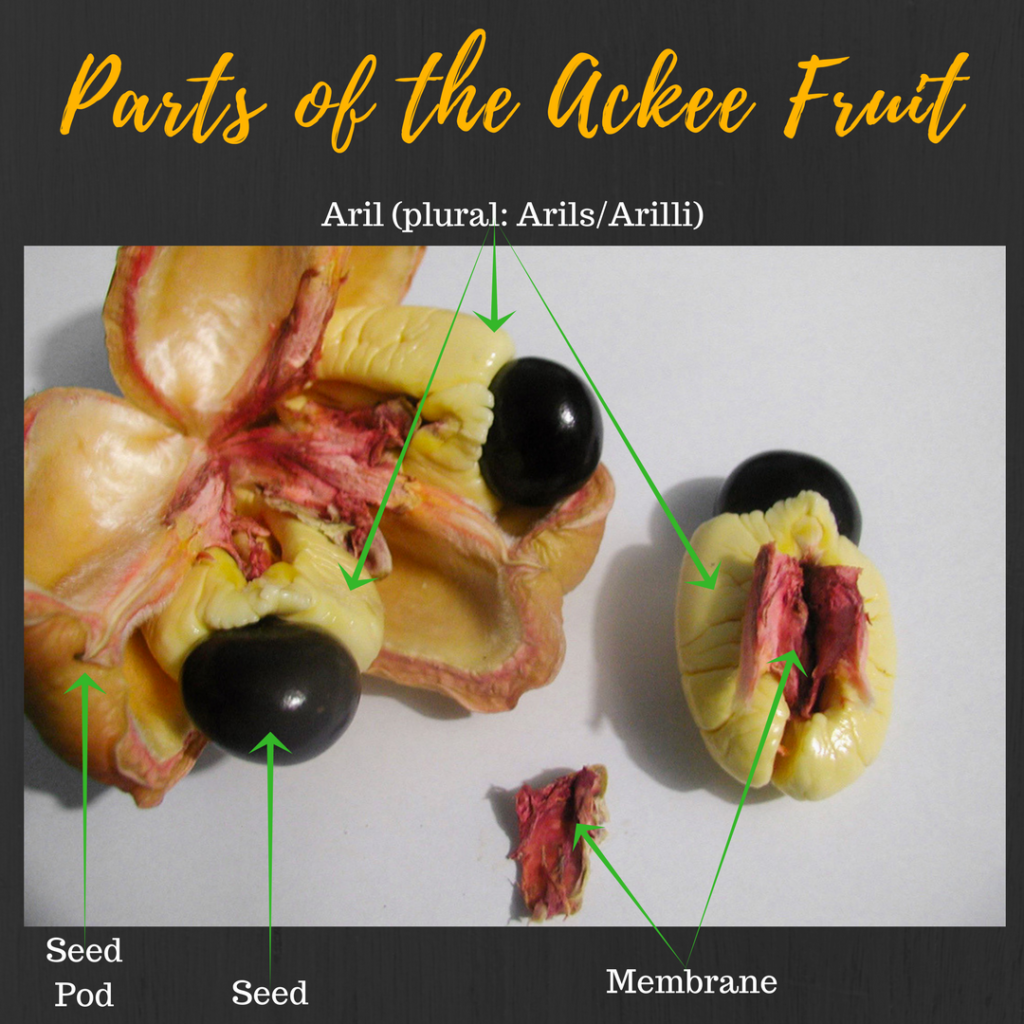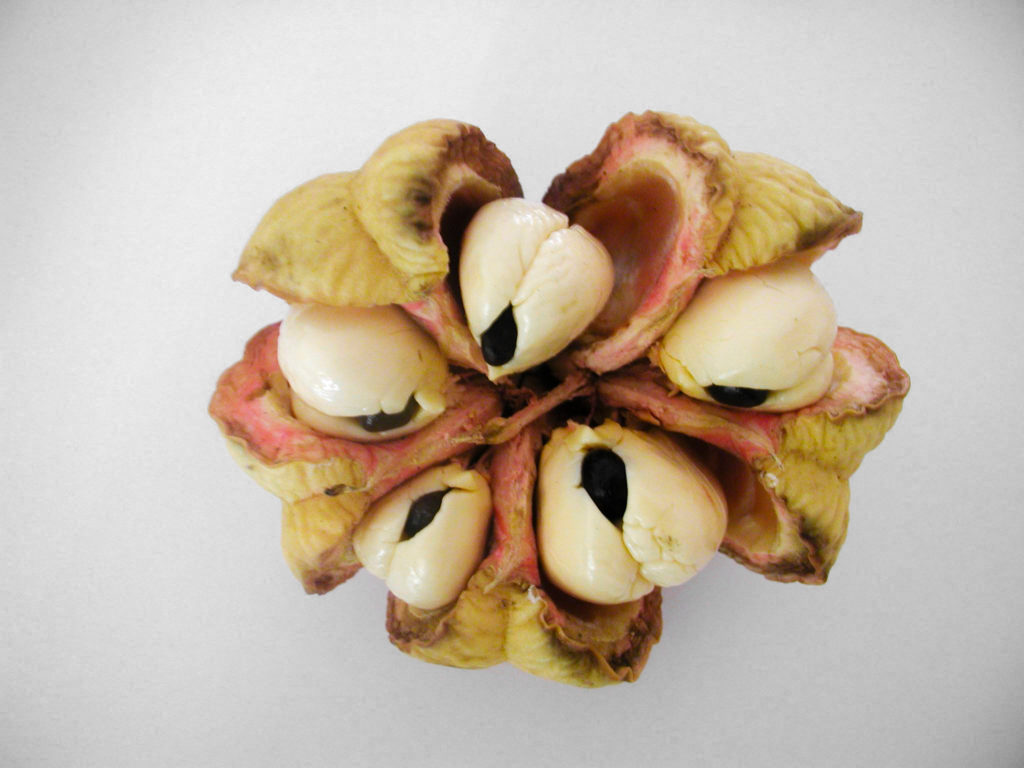What is Ackee? Is it a Fruit or Vegetable?
What is ackee? This is a question I’m asked pretty often. I usually start by saying it’s a fruit! 😊
Though often thought of and prepared like a vegetable, ackee is a fatty fruit!
In fact, it is actually the whole pod that is the fruit, but when we talk about cooking or eating ackee however, we are referring specifically to the arils which are the only edible part of the fruit.
The photo below shows a mature opened fruit and it’s different parts:

Photo Credit: Dr. Sylvia Adjoa Mitchell

What do ackees taste like?
Ackees are firm and oily to the touch when raw and soften when cooked. You may have heard it described as being like scrambled eggs but appearance in some preparations aside, the taste is nothing like eggs and neither is the texture. Once cooked it is smooth and tend to melt in your mouth. The two descriptions (in my opinion) that come closest are “cheese fruit” and “vegetable marrow” both of which highlight the fruit’s creaminess (this is what makes it great for creamy sauces).
In some baking I’ve found it to tend towards having a nutty flavour close to peanut butter, and in custards the sweetness of the fruit shines through taking you to yet another dimension.
What is ackee called?
Other names for ackee are: Akye fufo, Ankye or Guinep (this one is particularly funny/confusing since there is a different fruit called guinep in Jamaica. I’ve witnessed on social media a Bajan (Barbadian) tagging a picture of guinep “ackee”, with some very perplexed Jamaicans commenting that the person must obviously not know what the heck they are talking about 😆)
Ackee & Jamaica
An evergreen native to West Africa, the ackee tree was brought to Jamaica in the 18th century most likely on a slave ship. The trees are found all over the island with Clarendon and St. Elizabeth being the main growing regions.

On a drive through Kingston one day, my mom and I noted that almost all the yards along the main road on Washington Boulevard had at least one ackee tree along with a breadfruit tree and/or a pear (avocado) tree (what a blessing when all of those are bearing! 😍)
Whereas it is poorly exploited for food in it’s homeland; it is widely consumed in Jamaica where it is the national fruit and one of the main components in the national dish: Ackee and Saltfish.
Fun fact: Jamaica is the only country that processes ackee commercially for export! This began in the 1950s (though there were some bumps and hiccups along the way – some of these issues along with toxicity is discussed here).
In the year 2016 ackee exports to the United States were valued at US$20 million; to give a little perspective: in 2000 exports were valued at US$4.4 million, wowza!
What are the different types of ackee?
Ackee in Jamaica is classified according to characteristics of the aril as either “butter” or “cheese” ackee. The aril of butter ackee is yellow in colour, soft, creamy and akin to butter; it mashes very easily when cooked. Cheese ackee on the other hand is pale cream in colour and firm, like cheese; it stands up better to being tossed around and will retain it’s shape.
Butter ackee is perfect baking quick breads and cakes; custards and ice creams; and for drinks and smoothies where a silky smooth result is desired.
Cheese ackee is great for sautés and salads or any dish where you want the shape of the ackee to stay in tact.
How to cook with different types of ackee
So what do you do if you’re not sure what kind you have or if you’re using canned ackees?
Do you have cheese ackee but want to make a recipe better suited for butter ackee?
Place the amount of ackee needed for the recipe in a pot with a small amount of water and a pinch of baking soda and let it simmer over a low heat until all the water evaporates.
The baking soda will soften the ackee making it easy to puree. This can be done by blending it or pureeing it in a food processor. Alternately you can pass it through a fine sieve.
Do you have butter or canned ackee and want to make a recipe better suited for cheese ackee?
Simply wait till the very end to add the ackee and toss it gently so it doesn’t break up too much.
Now you know what ackee is
My hope is that you found this post informative.
Be sure to check out the two other ackee information pages. “Ackee Nutrition” which outlines the calories and macronutrient breakdown of the fruit and give a bit of info on the vitamins and minerals they contain. And “Ackee Concerns” which details the concerns with toxicity, separating the hype and scare tactics from the facts.
Have you ever seen or tried ackee? I’d love to hear from you. Please share your thoughts in the comments section below.
If you have any other questions about ackee that are not addressed here or on the other two pages noted, feel free to leave that question in the comments section also and I’ll answer it and update this page as needed.
Thank you so much for stopping by. Have a look around at some of the recipes and allow me to blow your mind at all of the things ackee can do 🙃
Photos used and credited above are the property of Dr. Sylvia Adjoa Mitchell, Senior Lecturer, Medicinal Plant Research Group, The Biotechnology Centre, UWI Mona, Jamaica
They are reproduced here with her permission for educational purposes.
Source: Mitchell, Sylvia & Webster, SA & Ahmad, MH. (2008). Ackee (Blighia sapida) – Jamaica’s top fruit. Jamaica Journal. 31. 84-89.
To read the full paper, click here to access the link to download it on Researchgate
